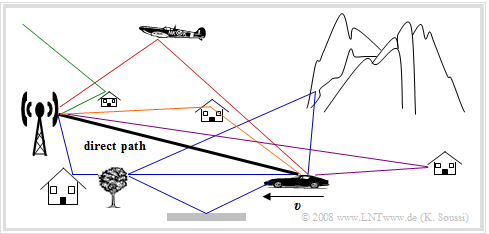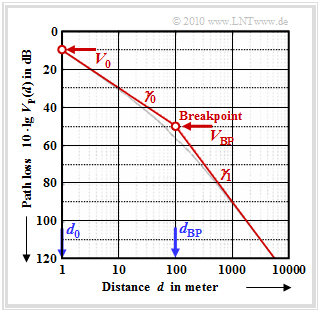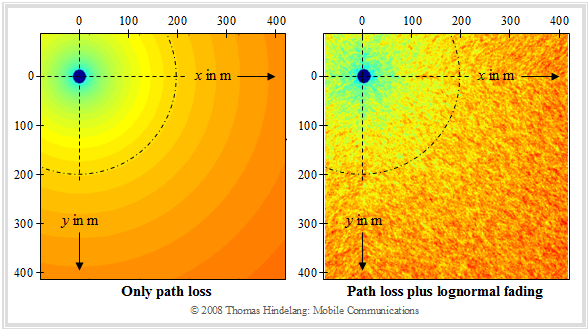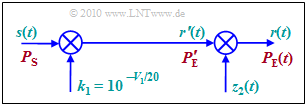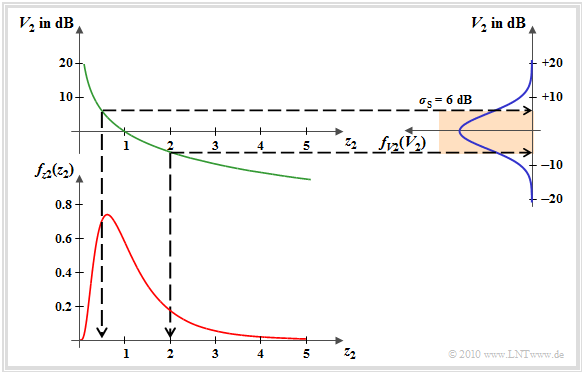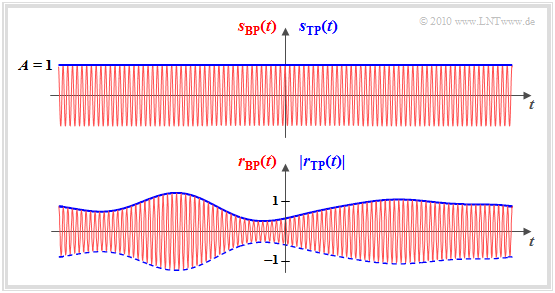Contents
- 1 # SYNOPSIS OF THE FIRST MAIN CHAPTER #
- 2 Physikalische Beschreibung des Mobilfunkkanals
- 3 Free space propagation
- 4 Common path loss model
- 5 Other, more accurate path loss models
- 6 Additional loss due to shadowing
- 7 Lognormal–Kanalmodell
- 8 Zeitbereichsmodell für das Lognormal–Fading
- 9 Voraussetzungen für die folgenden Kapitel
- 10 Aufgaben zum Kapitel
- 11 Quellenverzeichnis
# SYNOPSIS OF THE FIRST MAIN CHAPTER #
The first main chapter deals with time-variant transmission channels, a property that is of great importance for mobile communication. The description is given throughout in the equivalent low-pass range.
It deals in detail with the following topics:
- the distance-dependent attenuation of a radio signal and various path loss models,
- the influence of shadowing , modelable through Lognormal-Fading
- the non-frequency selective Rayleigh fading for channels without "Line of Sight (LoS)",
- the consideration of the Doppler effect by the so-called Jakes spectrum
- the non-frequency selective Rice-Fading for channels with direct path (Line of Sight).
Physikalische Beschreibung des Mobilfunkkanals
The figure shows a typical mobile radio scenario with a fixed base station and a mobile subscriber moving towards the base station at the speed $v$ .
In this representation, the radio signal reaches the mobile station via a direct path.
However, the antenna of the mobile subscriber also receives other signal components that reach the receiver in a detour, for example
- due to reflections on houses,
- a mountain range,
- a plane,
- the ionosphere,
- the ground.
This scenario can be used to explain important problems in mobile communications:
- Path Loss : This measures the attenuation of the electromagnetic wave, which depends to a large extent on the distance between transmitter and receiver.
- Shadowing : This describes a slow change in reception conditions due to the changing environment, for example when you pass a building or when you leave a wooded area.
- Multipath Propagation : If the signal reaches the receiver on several paths with differences in propagation time, constructive or destructive superimpositions up to complete extinction occur, depending on the signal frequency. For certain frequencies the topology is favorable, for others unfavorable. Therefore this effect is also called frequency selective fading
- Time Variance : The effect is caused by the movement of the transmitter and/or the receiver, because there is a different channel at each time. The transmission quality decreases rapidly if the direct path is shadowed by an obstacle. The received signal is then composed only of the partial signals arriving on detours, which are attenuated compared to the direct path due to scattering from trees and bushes and possibly refraction– and diffraction phenomena, and which add vectorially to the total signal.
- Doppler effect : Depending on whether (and also at what angle) the mobile station is moving towards or away from the transmitter, (slight) frequency shifts occur and thus statistical links within the received signal, which cause pulse interference .
In this chapter we will take a closer look at path loss and shadowing effects. The following chapters deal with time variance, also taking into account the Doppler effect. The second main chapter describes multipath propagation, which results in echoes in mobile radio.
Free space propagation
One speaks of "free space propagation" when there is a line of sight between the transmitter and the receiver positioned at a distance $d$ as in satellite communications or in space. The radio waves propagate in „empty space” unhindered spherically around the transmitting antenna, but are attenuated with increasing distance due to the law of conservation of energy.
Geometrically you can imagine that the radius $R$ of the sphere and thus also the spherical surface become larger and larger and at constant total energy the energy per unit area becomes proportional to $1/R^2$ smaller and smaller.
We assume an unmodulated oscillation of the frequency $f_{\rm S}$ or of the wavelength $\lambda= c/f_{\rm S}$ where $c = 3 \cdot 10^8\ \rm m/s$ indicates the speed of light , the signal power is $P_{\rm S}$.
Harald Friis gave an equation in 1944 for the reception power $P_{\rm E}(d)$ from the distance $d$ this equation, however, is only valid in a vacuum:
- \[P_{\rm E}(d) = \frac{P_{\rm S} \cdot G_{\rm S} \cdot G_{\rm E} \cdot \lambda^2}{16 \cdot \pi^2 \cdot d^2 \cdot V_{\rm zus}} = \frac{P_{\rm S} \cdot G_{\rm S} \cdot G_{\rm E} /V_{\rm zus}}{K_{\rm FR}(d)} \hspace{0.05cm}.\]
- $G_{\rm S}$ and $G_{\rm E}$ indicate the antenna gains of transmitter and receiver, respectively.
- $V_{\rm zus} > 1$ summarizes all additional losses independent of the wave propagation, e.g. through the antennas's cable feeds.
- The Free space attenuation $K_{\rm FR}(d)$ depends on the distance $d$ :
- \[K_{\rm FR}(d) = K_{\rm FR}(d_0) \cdot (d/d_0)^2 \hspace{0.2cm}{\rm mit} \hspace{0.2cm} K_{\rm FR}(d_0) = ({4 \pi d_0}/{\lambda} )^2 \hspace{0.05cm}.\]
Usually the free space attenuation is specified logarithmically with the pseudo unit „dB” Then the power loss due to free space attenuation ("V" stands for "Verlust" (loss) in dB):
- \[V_{\rm FR}(d) = 10 \cdot {\rm lg} \hspace{0.1cm} K_{\rm FR}(d) = V_{\rm 0} + 20\,\,{\rm dB} \cdot {\rm lg} \hspace{0.1cm} (d/d_0)\hspace{0.05cm},\hspace{0.5cm} V_{\rm 0} = V_{\rm FR}(d_0) = 20\,\,{\rm dB} \cdot {\rm lg} \hspace{0.2cm} ({4 \pi d_0}/{\lambda}) \hspace{0.05cm}.\]
It should be noted about this equation:
- The equation only applies in the far field of the antenna $(d > d_{\rm F})$. Here $d_{\rm F} = 2 D^2/\lambda$ the so-called Fraunhofer–Distance. For $D$ the largest physical dimension of the transmitting antenna must be used.
- The equation does not apply to $d \to 0$. This would result in the limit value $K_{\rm FR} \to 0$, and it would result independently from $P_{\rm S}$ always an infinite receiving power $P_{\rm E}(d \to 0)$.
- The free space attenuation $K_{\rm FR}(d)$ increases with increasing distance $d$ increases quadratically and also quadratically with increasing signal frequency $f_{\rm S}$, that is, with decreasing wavelength $\lambda$.
- For example, for GSM/E–network $(f_{\rm S} = 1.8 \ \rm GHz$ ⇒ $\lambda \approx 17 \ \rm cm)$: $K_{\rm FR}(d = 1\ \rm km) = 1.6 \cdot 10^9$. The receiver at a distance of one kilometer does not receive even one billionth of the transmitting power.
In the Task 1.1Z the above Friis–equation is to be numerically evaluated and interpreted. Usually, the free space attenuation is set in relation to a suitable normalization distance to be defined $d_0$ ⇒ $K_{\rm FR}(d/d_0)$, where $d_0 = 1\ \rm m$ is often used.
Common path loss model
In contrast to satellite and directional transmission links, in the case of land mobile radio, in addition to free-space attenuation, other disturbing effects which also contribute to a reduction in reception power must be taken into account, namely:
- Reflections: By superimposing the transmitted signal with a signal component reflected on the ground or on other large smooth surfaces, cancellations can occur which cause a decrease in the reception power up to the fourth power of the distance $d$ between transmitter and receiver. For more information, see [Zan05][1] and [PA95][2].
- Diffraction: This is when the signal is not reflected but deflected from its direction of propagation, for example at the edge of a building. A physical explanation can be found again in [Zan05][1].
- Dispersion: If the connection transmitter – receiver is interrupted by several objects with irregular surfaces (for example trees or bushes) the signal arrives at the receiver in the form of many scattered signals with slightly different propagation times. The size of the obstacle determines whether it is to be interpreted as a reflecting or as a scattering object.
The effects mentioned here are responsible for the fact that mobile radio can be operated without direct line of sight, and thus one of the bases for the economic success of mobile radio systems. Negatively, these effects are caused by a lower reception power, which must be taken into account by a larger exponent than $\gamma = 2$ . We then no longer speak of free space attenuation, but generally of "path attenuation factor":
- \[K_{\rm P}(d) = K_{\rm P}(d_0) \cdot (d/d_0)^\gamma \hspace{0.05cm}.\]
The corresponding dB–magnitude we call the path loss $(\rm lg$ is the logarithm to the base $10)$:
- \[V_{\rm P}(d) = V_{\rm 0} + \gamma \cdot 10\,{\rm dB} \cdot {\rm lg} \hspace{0.1cm} (d/d_0)\hspace{0.05cm},\hspace{0.5cm} V_{\rm 0} = V_{\rm P}(d_0) = \gamma \cdot 10\,{\rm dB} \cdot {\rm lg} \hspace{0.1cm} \frac{4 \cdot \pi \cdot d_0}{\lambda}\hspace{0.05cm}. \]
From these equations it can be seen that the free space attenuation $V_{\rm FR}(d)$ is a special case of $V_{\rm P}(d)$ with $\gamma = 2$ . In [Zan05][1] numerical values are given for the exponent $\gamma$ which were determined as mean values over a large number of measurements. Among other things
- in clear view (satellite, radio relay): $\gamma \approx 2$,
- in an urban setting: $\gamma = 2.7 \ \text{...} \ 3.5$,
- in a shaded urban setting: $\gamma = 3.0\ \text{...} \ 5.0$,
- Inside buildings without a line of sight: $\gamma = 4.0 \ \text{...} \ 6.0$.
Other, more accurate path loss models
The relatively simple path loss model shown on the last page is well suited for macro cells, but requires high base station antennas. It was used, for example, as a reference–scenario for the standardization of Long Term Evolution (LTE).
Of course, this very simple two–parameter model $(V_0, \ \gamma)$ cannot reproduce all use cases with sufficient accuracy. A large number of other models for power attenuation can be found in the literature, which are more precisely adapted to specific boundary conditions. (neighbourhood) and also take different cell sizes into account. Well-known are for example, siehe [Gol06][3]:
- the Okumura–Hata model,
- the path loss model according to COST 231,
- the Dual–Slope model.
$\text{Example 1:}$ The Dual–Slope model is often used for simulations of micro cells in urban areas. The equation is the following, with the parameters $d_0 = 1\ \rm m$ und $d_{\rm BP}$ $($Breakpoint, beispielsweise $d_{\rm BP} = 100\ \rm m)$:
- \[V_{\rm P}(d) \hspace{-0.05cm} = \hspace{-0.05cm} V_{\rm 0} \hspace{-0.05cm}+\hspace{-0.05cm} \gamma_0 \hspace{-0.05cm}\cdot \hspace{-0.05cm} 10\,{\rm dB} \hspace{-0.05cm}\cdot \hspace{-0.05cm}{\rm lg} \hspace{0.01cm} \left ( {d}/{d_0} \right ) \hspace{-0.05cm}+ \hspace{-0.05cm}(\gamma_1 \hspace{-0.05cm}- \hspace{-0.05cm}\gamma_0) \hspace{-0.05cm}\cdot \hspace{-0.05cm}10\,{\rm dB} \hspace{-0.05cm}\cdot\hspace{-0.05cm} {\rm lg} \hspace{0.01cm} \left (1+ {d}/{d_{\rm BP} } \right )\hspace{0.05cm}.\]
The graph shows this curve for $V_{\rm 0} = 10 \ {\rm dB}$, $\gamma_0 = 2$ und $\gamma_1 = 4$ in the range from one meter to several kilometers (thin grey curve).
To simplify matters, the asymptotic approximation shown in red in the graph is used
- \[V_{\rm P}(d) = \left\{ \begin{array}{c} V_{\rm 0} + \gamma_0 \cdot 10\,{\rm dB} \cdot {\rm lg} \hspace{0.1cm} (d/d_0)\hspace{0.05cm},\\ V_{\rm BP} + \gamma_1 \cdot 10\,{\rm dB} \cdot {\rm lg} \hspace{0.1cm} (d/d_{\rm BP})\hspace{0.05cm}, \end{array} \right.\quad \begin{array}{*{1}c} {\rm f\ddot{u}r} \hspace{0.15cm}d < d_{\rm BP}\hspace{0.05cm}, \\ {\rm f\ddot{u}r} \hspace{0.15cm} d \ge d_{\rm BP}\hspace{0.05cm} \\ \end{array}\]
The value $V_{\rm BP} = 50 \ {\rm dB}$ is derived from the equation for the first section at the border $d = 100\ \rm m$ of the scope.
Note: In the Aufgabe 1.1 this model is still being examined in detail.
Additional loss due to shadowing
The disturbing influence of shading is explained with the help of a graphic, taken from the lecture manuscript [Hin08][4] :
- The previous path loss models only take into account the distance-dependent signal attenuation according to the left graph and disregard topological factors such as the influence of shading.
- In land mobile radio, shadowing (english: Shadowing) causes the signal level to vary even when moving at the same distance from the base station (on an arc of a circle) .
- This is shown in the right-hand graph, with darker areas indicating greater path loss. The difference between the left and right images is due to "Shadowing".
The effects of shadowing can be summarised as follows:
- For stationary transmitters and receivers, the shadowing is to be considered deterministic. It causes the path loss due to the shadowing to change by a constant value $V_{\rm S}$ (in dB):
- \[V_{\rm P}(d) = V_{\rm 0} + \gamma \cdot 10\,{\rm dB} \cdot {\rm lg} \hspace{0.1cm} (d/d_0)+ V_{\rm S}\hspace{0.05cm}. \]
- If the receiver (or the sender) moves, the shadowing–loss changes according to the coordinates and therefore also with time. This means: $V_{\rm S}$ ⇒ $V_{\rm S}(x, y)$ bzw. $V_{\rm S}$ ⇒ $V_{\rm S}(t)$.
- However, such channel changes are very slow due to shading. Often the conditions remain the same for several seconds and one speaks here of "Long Term Fading" in contrast to fast fading like Rayleigh–Fading and Rice–Fading.
Lognormal–Kanalmodell
Zur Berücksichtigung des Verlustes $V_{\rm S}$ durch Shadowing muss man bei der Systemplanung auf statistische Modelle zurückgreifen, die sich aus empirischen Untersuchungen ergeben haben.
Am bekanntesten ist das Lognormal–Kanalmodell, das für die Zufallsvariable $V_{\rm S}$ eine Gaußsche WDF zugrundelegt:
- \[f_{V_{\rm S}}(V_{\rm S}) = \frac {1}{ \sqrt{2 \pi }\cdot \sigma_{\rm S}} \cdot {\rm e }^{ - { (V_{\rm S}\hspace{0.05cm}- \hspace{0.05cm}m_{\rm S})^2}/(2 \hspace{0.05cm}\cdot \hspace{0.05cm}\sigma_{\rm S}^2) } \hspace{0.05cm}.\]
Der Name „Lognormal” ergibt sich aus der Tatsache, dass die dB–Größe $V_{\rm S}$, die über den Logarithmus aus dem linearen Leistungsdämpfungsfaktor abgeleitet wird, normalverteilt (und damit gaußisch) ist.
Das Lognormal–Kanalmodell ist durch zwei Parameter bestimmt:
- Der Mittelwert $m_{\rm S} = {\rm E}\big [V_{\rm S}\big ]$ gibt den mittleren Shadowing–Verlust an. Für ländliches Gebiet wird meist mit $m_{\rm S} = 6 \ \rm dB$ gerechnet, für städtisches Gebiet geht man von $14 \ \rm dB$ ... $20 \ \rm dB$ aus.
- Auch die Standardabweichung (oder Streuung) $\sigma_{\rm S}$ ist für ländliches Gebiet $(\approx 6 \ \rm dB)$ bzw. für städtische Bedingungen $($zwischen $8 \ \rm dB$ und $12 \ \rm dB)$ unterschiedlich.
Beachten Sie, dass $V_{\rm S}$ beim Lognormal–Fading auch negative Werte annehmen kann (rote Hinterlegung in obiger Grafik), was der Vorstellung von Abschattung eigentlich widerspricht. In der Praxis hat sich dieses Modell allerdings als sehr gut erwiesen.
Den „Gewinn durch Abschattung” könnte man wie folgt interpretieren:
- In Häuserschluchten kann durch Reflexionen an Gebäuden mehr Energie ankommen, als es nach dem Pfadverlust zu erwarten wäre.
- Der Pfadverlustexponent $\gamma$ wird stets fest vorgegeben, zum Beispiel $\gamma = 3.76$ im städtischen Gebiet. Aber es gibt Positionen in der Stadt, bei denen $\gamma$ kleiner ist.
- Ein solch einfaches Modell kann nicht alle Details exakt abbilden. Man sollte daher nicht versuchen, alle Modelleigenschaften physikalisch zu interpretieren.
$\text{Fazit:}$ Es ist zweckmäßig, die Pfadverlustanteile in folgender Weise zusammenzufassen:
- \[V_{\rm P} = V_{\rm 1} + V_{\rm 2}(t) \hspace{0.25cm}{\rm mit}\hspace{0.25cm} V_{\rm 1} = V_{\rm 0} + \gamma \cdot 10\,{\rm dB} \cdot {\rm lg} \hspace{0.1cm} (d/d_0)+ m_{\rm S}\hspace{0.05cm}.\]
Der zweite Anteil $V_{\rm 2}(t)$ beschreibt nun eine Lognormal–WDF mit Mittelwert Null:
- \[f_{V_2}(V_2) = \frac {1}{ \sqrt{2 \pi }\cdot \sigma_{\rm S} } \cdot {\rm e }^{ - V_2 ^2/(2 \hspace{0.05cm}\cdot \hspace{0.05cm} \sigma_{\rm S}^2) }\hspace{0.05cm}.\]
Die Entfernungsabhängigkeit von $V_1$ spielt keine große Rolle und wird hier nicht weiter betrachtet.
Zeitbereichsmodell für das Lognormal–Fading
Die Grafik zeigt ein Zeitbereichsmodell, mit dessen Hilfe der Pfadverlust $V_{\rm P}$ gemäß obiger Gleichung simulativ nachgebildet werden kann. Hierzu ist anzumerken:
- Das Eingangssignal $s(t)$ besitze die Leistung $P_{\rm S}$. In logarithmischer Darstellung wird die Leistung auf $1\ \rm mW$ bezogen und es wird die Pseudoeinheit „dBm” hinzugefügt.
- Der Pfadverlust $V_1$ wird durch die Multiplikation mit $k_1$ erzeugt. Das Ausgangssignal $r'(t)$ hat dann eine um $V_1$ (in dB) kleinere Leistung:
- \[k_1 = 10^{-V_{\rm 1}/20} \hspace{0.1cm} \Rightarrow \hspace{0.1cm} 10 \cdot {\rm lg} \hspace{0.1cm} \frac{P_{\rm E}\hspace{0.05cm}' }{\rm 1\,mW}= 10 \cdot {\rm lg} \hspace{0.1cm} \frac{P_{\rm S} }{\rm 1\,mW} + 20 \cdot {\rm lg} \hspace{0.1cm} k_1 = 10 \cdot {\rm lg} \hspace{0.1cm} \frac{P_{\rm S} }{\rm 1\,mW} - V_1 \hspace{0.05cm}.\]
- Das (mittelwertfreie) Lognormal–Fading wird durch Multiplikation mit der Zufallsgröße $z_2(t)$ nachgebildet.
- Die WDF ergibt sich aus der Gaußschen Zufallsgröße $V_2$ durch eine nichtlineare Transformation an der Kennlinie
- $$z_2 = g(V_2) = 10^{-V_{\rm 2}/20}.$$
- Für $z_2< 0$ ist diese WDF gleich Null, und für $z_2\ge 0$ gilt mit der Abkürzung $C = \rm ln(10)/20 dB$:
- $$f_{z_{\rm 2}}(z_{\rm 2}) = \frac {{\rm e^{- {\rm ln}^2 (z_{\rm 2}) /({2 \hspace{0.05cm}\cdot \hspace{0.05cm} C^2 \hspace{0.05cm} \cdot \hspace{0.05cm} \sigma_{\rm S}^2}) } } }{ \sqrt{2 \pi }\cdot C \cdot \sigma_{\rm S} \cdot z_2} \hspace{0.05cm}.$$
Die Grafik verdeutlicht die Transformation. Man erkennt
- die Gauß–WDF von $V_2$ (blau) mit Streuung $\sigma_{\rm S} = 6 \ \rm dB$,
- die negativ–logarithmische Kennlinie (grün), sowie
- die unsymmetrische WDF (rot) der zu multiplizierenden Größe $z_2(t)$.
Wir verweisen hier auf die Aufgabe 1.2Z.
Voraussetzungen für die folgenden Kapitel
Die mittlere Leistung aller am Empfänger ankommenden Signalanteile können mit Hilfe von Pfadverlust– und Abschattungsmodell berechnet werden.
- Das Lognormal–Abschattungsmodell berücksichtigt langsame Änderungen der Reflektoren aufgrund der Topologie, wobei sich die Empfangsbedingungen in Städten nur alle fünf bis zehn Meter ändern und auf dem Land nur alle 30 bis 100 Meter.
- Im Folgenden wird der Pfadverlust und der Einfluss von Abschattungen nicht weiter betrachtet, sondern auf $1$ normiert.
Pfade können sich konstruktiv oder destruktiv überlagern. Die damit zusammenhängenden Änderungen ergeben sich örtlich im Bereich der halben Wellenlänge. Beim Mobilfunk genügen dabei schon einige wenige Zentimeter, um völlig andere Empfangsbedingungen vorzufinden. Man spricht von Fast Fading. Ein solcher Kanal ist grundsätzlich frequenz– und zeitabhängig.
Für den Rest dieses ersten Hauptkapitel wird die Frequenzabhängigkeit dadurch eliminiert, dass wir von einer einzigen festen Frequenz ausgehen (siehe Grafik).
Es gelten somit ab sofort folgende Voraussetzungen:
- Das Eingangssignal des Mobilfunkkanals sei eine Cosinusschwingung mit der Amplitude $A = 1$ und der Frequenz $f_{\rm T}$. Wir bezeichnen diese harmonische Schwingung als das „Sendesignal” $s_{\rm BP}(t)$. Dieses Bandpass–Signal ist in der oberen Grafik rot dargestellt.
- Das Ausgangssignal $r_{\rm BP}(t)$ des Mobilfunkkanals – im Folgenden „Empfangssignal” genannt – kann sich von $s_{\rm BP}(t)$ sowohl in der Amplitude (Hüllkurve) als auch in der Phase unterscheiden ⇒ untere Grafik, rot.
- Wir betrachten des Weiteren den Mobilfunkkanal meist im äquivalenten Tiefpassbereich. Das „Sendesignal” ist dann $s_{\rm TP}(t) = 1$ und somit reell ⇒ blaue Horizontale in der oberen Grafik.
- Das TP–Ausgangssignal $r_{\rm TP}(t)$ ist im Allgemeinen komplex, wobei die Hüllkurve durch $a(t)$ gegeben ist und sich die Phase $\phi(t)$ durch Verschiebungen der Nulldurchgänge bemerkbar macht ⇒ blaue Hüllkurve in der unteren Grafik.
$\text{Fazit:}$ Für das physikalische (Bandpass–)Signal am Ausgang des Mobilfunkkanals gelte im Folgenden stets:
- \[r_{\rm BP}(t) = a(t) \cdot \cos \big [2\pi f_{\rm T} t + \phi(t)\big ]\hspace{0.3cm}\Rightarrow \hspace{0.3cm} a(t) = \vert r_{\rm BP}(t)\vert\hspace{0.05cm}, \hspace{0.2cm} \phi(t) = {\rm arc}\hspace{0.15cm} r_{\rm BP}(t)\hspace{0.05cm}.\]
Aufgaben zum Kapitel
Exercise 1.1: Dual Slope Loss Model
Aufgabe 1.1Z: Einfaches Pfadverlustmodell
Aufgabe 1.2: Lognormal – Kanalmodell
Aufgabe 1.2Z: Nochmals Lognormal–Fading
Quellenverzeichnis
- ↑ 1.0 1.1 1.2 Zangl, J.: Multi-Hop-Netze mit Kanalcodierung und Medium Access Controll (/MAC). Düsseldorf: VDI Verlag, Reihe 10, Nummer 761, 2005.
- ↑ Pahlavan, K.; Allen, L.: Wireless Information Networks. New York: John Wiley & Sons, Wiley Series in Telecommunications and Signal Processing, 1995.
- ↑ Goldsmith, A.: Wireless Communications. Cambridge University Press, Cambridge, UK, 2006.
- ↑ Hindelang, T.: Mobile Communications. Vorlesungsmanuskript. Lehrstuhl für Nachrichtentechnik, Technische Universität München, 2008.
